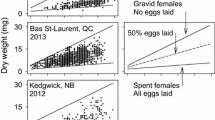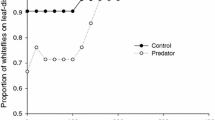Abstract
Release of arthropod predators holds promise for suppressing herbivorous insect populations in commercial crops below economic threshold levels, but dispersal from release sites remains a practical issue that can limit their impact. This study examined mating behavior, survival, reproduction, and dispersion of membranous wing-clipped and wing-intact adults of the predatory stinkbug Podisus nigrispinus (Dallas) (Hemiptera: Pentatomidae), a generalist predator of cotton pests in South America. After laboratory studies demonstrated that wing-clipping did not alter mating behavior or reproductive output, field studies were conducted in experimental plots. In each experiment, 50 mated females (5–10 days old) were released at a central point. After 24, 48, 72, and 96 h, dispersion was measured via drop-cloth samples at distances up to 16 m from the release point. After 96 h, plants on each survey and release point were collected and, in the laboratory, they were inspected for egg masses. During the first 24 to 48 h after release, predators from both groups disappeared, but recovery of the wing-clipped predators was significantly greater (38.6% for wing-clipped and 17.3% for wing-intact predators) in all three releases. Importantly, oviposition rates on the release site were about three times greater for wing-clipped females (0.07 vs. 0.02 egg masses per plant), indicating that limiting flight induces females to stay and lay their eggs, hence, allowing local establishment of a new generation of predators.

Similar content being viewed by others
References
Carvalho RDS, Vilela EF, Borges M, Zanuncio JC (1994) Ritmo do comportamento de acasalamento e atividade sexual de Podisus connexivus Bergroth (Heteroptera: Pentatomidae: Asopinae). Ann Soc Entomol Brasil 23:197–202
Cody RP, Smith JK (1997) Applied statistics and the SAS® programming language. Prentice Hall, Upper Saddle River
De Clercq P (2000) Predaceous stinkbugs (Pentatomidae: Asopinae). In: Schaefer CW, Panizzi AR (eds) Heteroptera of economic importance. CRC Press, Boca Raton, pp 737–789
De Clercq P, Degheele D (1992) Influence of feeding interval on reproduction and longevity of Podisus sagitta (Het.: Pentatomidae). Entomophaga 37:583–590
Degrande PE (1998) Guia prático de controle das pragas do algodoeiro UFMS, Dourados
Evangelista Junior WS, Gondim Jr MGC, Torres JB, Marques EJ (2004) Fitofagia de Podisus nigrispinus em algodoeiro e plantas daninhas. Pesq Agropec Bras 39:413–420
Evans EW, Richards DR (1997) Managing the dispersal of ladybird beetles (Col.: Coccinellidae): use of artificial honeydew to manipulate spatial distributions. Entomophaga 42:93–102
Eveleens KG, van den Bosch R, Ehler LE (1973) Secondary outbreak induction of beet armyworm by experimental insecticide applications in cotton in California. Environ Entomol 2:497–503
França IWB, Marques EJ, Torres JB, Oliveira JV (2006) Interações dos Fungos Metarhizium anisopliae (Metsch.) Sorok. e Beauveria bassiana (Bals.) Vuill. com o percevejo predador Podisus nigrispinus (Dallas) (Heteroptera: Pentatomidae). Neotrop Entomol 35:346–356
Gazzoni DL (1998) Effect of stink bug populations on the yield, seed quality and agronomic traits of soybeans. Pesq Agropec Bras 33:1229–1237
Grundy PR, Maelzer DA (2002) Factors affecting the establishment and dispersal of nymphs of Pristhesancus plagipennis Walker (Hemiptera: Reduviidae) when released onto soybean, cotton and sunflower crops. Aust J Entomol 41:272–278
Hagen KS, Bomborosch S, McMurtry JA (1976) The biology and impact of predators. In: Huffaker CB, Messenger PS (eds) Theory and practice of biological control. Academic Press, New York, pp 93–142
Hagerty AM, Kilpatrick AL, Turnipseed SG, Sullivan MJ (2005) Predaceous arthropods and lepidopteran pests on conventional, Bollgard, and Bollgard II cotton under untreated and disrupted conditions. Environ Entomol 34:105–114
IBGE (Instituto Brasileiro de Geografia e Estatística) (2007) Indicadores IBGE: Estatística da Produção Agrícola/Setembro de 2007. Available online at http://www.ibge.gov.br/home/ (Accessed October 2007)
Ignoffo CM, Garcia C, Dickerson WA, Smidt GT, Biever KD (1977) Imprisonment of entomophages to increase effectiveness: evaluation of a concept. J Econ Entomol 70:292–294
Lambdin PL, Baker AM (1986) Evaluation of dewinged spined soldier bugs, Podisus maculiventris (Say), for longevity and suppression of the Mexican bean beetle, Epilachna varivestis Mulsant, on snapbeans. J Entomol Sci 21:263–266
McPherson JE (1980) A list of the prey species of Podisus maculiventris (Hemiptera: Pentatomidae). Great Lakes Entomol 13:17–24
Mensah RK (2002) Development of an integrated pest management programme for cotton. Part: 1 Establishing and utilizing natural enemies. Int J Pest Manag 48:87–94
Molina-Rugama AJ, Zanuncio JC, Vinha TV, Ramalho FS (2001) Daily rate of egg laying of the predator Podisus rostralis (Stal) (Heteroptera, Pentatomidae) under different feeding intervals. Rev Bras Entomol 45:1–5
Murdoch WW, Oaten A (1975) Predation and population stability. Adv Ecol Res 9:1–13
Oliveira JEM, Torres JB, Carrano-Moreira AF, Ramalho FS (2002) Biologia de Podisus nigrispinus predando lagartas de Alabama argillacea em campo. Pesq Agropec Bras 37:7–14
Olson DM, Wäckers FL (2007) Management of field margins to maximize multiple ecological services. J Appl Ecol 44:13–21
Ramalho FS (1994) Cotton pest management: Part 4. A Brazilian perspective. Annu Rev Entomol 39:563–578
Sant’Ana J, Bruni R, Abdul-Baki AA, Aldrich JR (1997) Pheromone-induced movement of nymphs of the predator, Podisus maculiventris (Heteroptera: Pentatomidae). Biol Control 10:123–128
SAS Institute (1999–2001) SAS/STAT User’s guide, version 8.02, TS level 2MO. SAS Institute Inc., Cary
Silva AGA, Gonçalves CR, Galvão DM, Gonçalves AJL, Gomes J, Silva M, Simoni L (1968) Quarto catálago dos insetos que vivem nas plantas do Brasil—seus parasitos e predadores, vol 1. Ministério da Agricultura, Rio de Janeiro, Brasil
Slosser JE, Parajulee MN, Bordovsky DG (2000) Evaluation of food sprays and relay strip crops for enhancing biological control of bollworms and cotton aphids in cotton. Int J Pest Manag 46:267–275
Torres JB, Evangelista Junior WS, Barros R, Guedes NC (2002) Dispersal of Podisus nigrispinus (Heteroptera: Pentatomidae) nymphs preying on tomato leafminer: effect of predator release time, density and satiation level. J Appl Entomol 126:326–332
Torres JB, Zanuncio JC, Moura MA (2006) The predatory stinkbug Podisus nigrispinus: biology, ecology and augmentative releases for lepidopteran larval control in Eucalyptus in Brazil. Persp Agric Vet Sci 15:1–14
Tourniaire R, Ferran A, Giuge L, Piotte C, Gambier J (2000) A natural flightless mutation in the ladybird, Harmonia axyridis. Entomol Exp Appl 96:33–38
van Lenteren J (2000) A greenhouse without pesticides: fact or fantasy? Crop Prot 19:375–384
Waddill V, Shepard M (1975) Dispersal of Podisus maculiventris nymphs in soybeans. Environ Entomol 4:233–234
Whitcomb WH (1974) Natural populations of entomophagous arthropods and their effect on the agroecosystem. In: Maxwell FG, Harris FA (eds) Proceedings of the summer institute of biological control of plant insect and diseases. The University Press of Mississippi, Jackson, pp 50–164
Wilson AGL (1989) Improved persistence of oil-based compared with water-based formulations of endosulfan on cotton foliage. Trop Pest Manag 35:62–64
Yang LH (2000) Effects of body size and plant structure on the movement ability of a predacious stinkbug, Podisus maculiventris (Heteroptera: Pentatomidae). Oecologia 125:85–90
Zanuncio JC, Guedes RNC, Oliveira HN, Zanuncio TV (2002) Uma década de estudos com percevejos predadores: conquistas e desafios. In: Parra JRP, Botelho PSM, Corrêa-Ferreira BS, Bento JMS (eds) Controle Biológico no Brasil: Parasitóides e Predadores. Manole, São Paulo, Brasil, pp 495–509
Acknowledgments
We thank Janice Matthews and Robert Matthews (UGA-Athens) for helpful suggestions on the manuscript as well as two anonymous reviewers and the associate editor of Biocontrol for valuable corrections and suggestions; Mario Castro for allowing us to use his land to grow field plots (Aldeia, PE), and Joel Strobel (Rondonópolis, MT) for allowing us to use his commercial fields. R.C.S.N. was funded by PIBIC/CNPq/UFRPE from August 2005 to August 2007. This research was supported in part by FACEPE/MCT/CNPq/CT-INFRA APQ-0157-5.01/06.
Author information
Authors and Affiliations
Corresponding author
Additional information
This research is part of a larger project looking for improvement of natural predators into sustainable pest management conducted by the biological control and insect ecology laboratory (lead by Jorge B. Torres) of the “Universidade Federal Rural de Pernambuco (UFRPE) at Recife, PE, Brazil.
Handling Editor: Patrick De Clercq
Rights and permissions
About this article
Cite this article
Neves, R.C.S., Torres, J.B. & Vivan, L.M. Reproduction and dispersal of wing-clipped predatory stinkbugs, Podisus nigrispinus in cotton fields. BioControl 54, 9–17 (2009). https://doi.org/10.1007/s10526-008-9150-4
Received:
Accepted:
Published:
Issue Date:
DOI: https://doi.org/10.1007/s10526-008-9150-4




